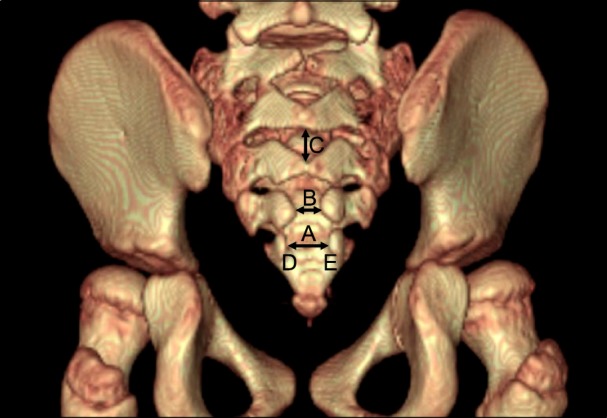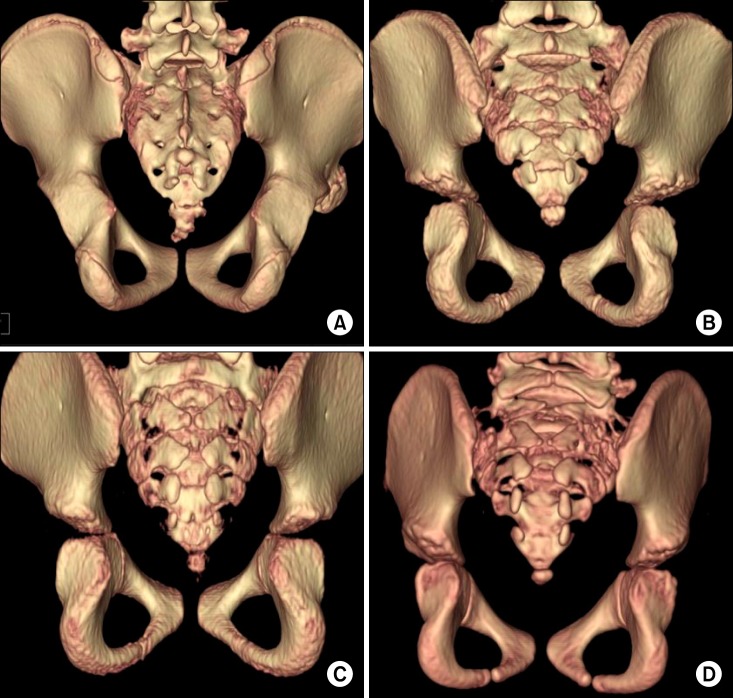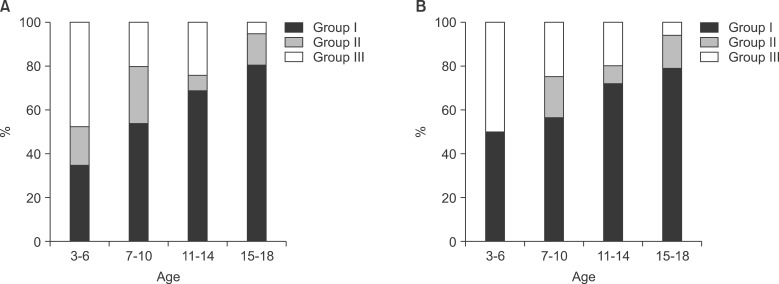Korean J Pain.
2014 Jul;27(3):253-259. 10.3344/kjp.2014.27.3.253.
Morphologic Diversities of Sacral Canal in Children; Three-Dimensional Computed Tomographic Study
- Affiliations
-
- 1Zeropain Clinic, Seoul, Korea.
- 2Seoul Pain Clinic, Seoul, Korea.
- 3Department of Anesthesiology and Pain Medicine, Seoul National University Bundang Hospital, Seongnam, Korea. hiitsme@snubh.org
- KMID: 2278234
- DOI: http://doi.org/10.3344/kjp.2014.27.3.253
Abstract
- BACKGROUND
Caudal block is a common technique in children for reducing postoperative pain, and there have been several reports on the variations of the sacral canal in children. However, previous studies have mainly focused on the needle trajectory for caudal block, and there is limited information on the structural variations of the sacrum in children. The purpose of this study was to analyze the anatomic variations of sacral canals in children.
METHODS
Three-dimensional computed tomographic images were analyzed. The data from the images included fusion of the sacral vertebral laminae and the sacral intervertebral space existence of the sacral cornua and the types of sacral hiatus. The types of sacral hiatus were classified into 3 groups: group I (fusion of S3 or S4 vertebral laminae), group II (unfused vertebral arch with the distance of the S3 and S4 vertebral laminae < 50% of the distance between the cornua), and group III (unfused vertebral arch with the distance of the S3 or S4 vertebral laminae > or = 50% of the distance between the cornua).
RESULTS
A total of 143 children were included in this study. All of the sacral vertebral arches were not fused in 22 children (15.4%). Cornua were not identified bilaterally in 5 (3.5%) and unilaterally in 6 (4.2%) children. In the sacral hiatus, group II and group III were identified in 22 (15.4%) and 31 (21.7%) children, respectively.
CONCLUSIONS
The sacral canal has various anatomical variations in children. Careful attention must be paid to identify the correct anatomic landmark.
MeSH Terms
Figure
Reference
-
1. Najman IE, Frederico TN, Segurado AV, Kimachi PP. Caudal epidural anesthesia: an anesthetic technique exclusive for pediatric use? Is it possible to use it in adults? What is the role of the ultrasound in this context? Rev Bras Anestesiol. 2011; 61:95–109. PMID: 21334512.
Article2. Beyaz SG. Comparison of postoperative analgesic efficacy of caudal block versus dorsal penile nerve block with levobupivacaine for circumcision in children. Korean J Pain. 2011; 24:31–35. PMID: 21390176.
Article3. Brenner L, Kettner SC, Marhofer P, Latzke D, Willschke H, Kimberger O, et al. Caudal anaesthesia under sedation: a prospective analysis of 512 infants and children. Br J Anaesth. 2010; 104:751–755. PMID: 20385572.
Article4. Aggarwal A, Aggarwal A, Harjeet , Sahni D. Morphometry of sacral hiatus and its clinical relevance in caudal epidural block. Surg Radiol Anat. 2009; 31:793–800. PMID: 19578805.
Article5. Aggarwal A, Sahni D, Kaur H, Batra YK, Sondekoppam Vijayashankar R. The caudal space in fetuses: an anatomical study. J Anesth. 2012; 26:206–212. PMID: 22076688.
Article6. Sekiguchi M, Yabuki S, Satoh K, Kikuchi S. An anatomic study of the sacral hiatus: a basis for successful caudal epidural block. Clin J Pain. 2004; 20:51–54. PMID: 14668657.
Article7. Aggarwal A, Kaur H, Batra YK, Aggarwal AK, Rajeev S, Sahni D. Anatomic consideration of caudal epidural space: a cadaver study. Clin Anat. 2009; 22:730–737. PMID: 19637298.
Article8. Broome DR, Hayman LA, Herrick RC, Braverman RM, Glass RB, Fahr LM. Postnatal maturation of the sacrum and coccyx: MR imaging, helical CT, and conventional radiography. AJR Am J Roentgenol. 1998; 170:1061–1066. PMID: 9530059.
Article9. Adewale L, Dearlove O, Wilson B, Hindle K, Robinson DN. The caudal canal in children: a study using magnetic resonance imaging. Paediatr Anaesth. 2000; 10:137–141. PMID: 10736075.
Article10. Busoni P, Sarti A. Sacral intervertebral epidural block. Anesthesiology. 1987; 67:993–995. PMID: 3688545.
Article11. Griffiths GJ, Evans KT, Roberts GM, Lloyd KN. The radiology of the hip joints and pelvis in cerebral palsy. Clin Radiol. 1977; 28:187–191. PMID: 870280.
Article12. Senoglu N, Senoglu M, Oksuz H, Gumusalan Y, Yuksel KZ, Zencirci B, et al. Landmarks of the sacral hiatus for caudal epidural block: an anatomical study. Br J Anaesth. 2005; 95:692–695. PMID: 16155035.
Article13. Shin SK, Hong JY, Kim WO, Koo BN, Kim JE, Kil HK. Ultrasound evaluation of the sacral area and comparison of sacral interspinous and hiatal approach for caudal block in children. Anesthesiology. 2009; 111:1135–1140. PMID: 19809281.
Article14. Nishiyama T, Hanaoka K, Ochiai Y. The median approach to transsacral epidural block. Anesth Analg. 2002; 95:1067–1070. PMID: 12351296.
Article15. Kumagai M, Yamashita M. Sacral intervertebral approach for epidural anaesthesia in infants and children: application of "drip and tube" method. Anaesth Intensive Care. 1995; 23:469–471. PMID: 7485939.
Article16. Ozaras N, Yalcin S, Ofluoglu D, Gureri B, Cabukoglu C, Erol B. Are some cases of spina bifida combined with cerebral palsy? A study of 28 cases. Eura Medicophys. 2005; 41:239–242. PMID: 16249782.
- Full Text Links
- Actions
-
Cited
- CITED
-
- Close
- Share
- Similar articles
-
- Radiological Evaluation of SI Posterior Screw Placement
- Analysis of Anterior-posterior Distance of Sacral Canal on MRI to See the Possibility of Sacral Laminar Hook Insertion
- Anthropologic Study of Korean Mandible Using Three--dimensional Computed Tomography--Evaluation of the Accuracy of a Three--dimensional Image
- High Prevalence of Dysplastic Development of Sacral Vertebral Arches in Pediatric Enuresis
- A Pitfall in the Use of Three Dimensional Computed Tomographic Angiography for Early Surgery of Ruptured Cerebral Aneurysm: Case Report




